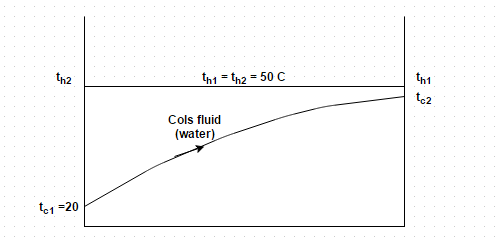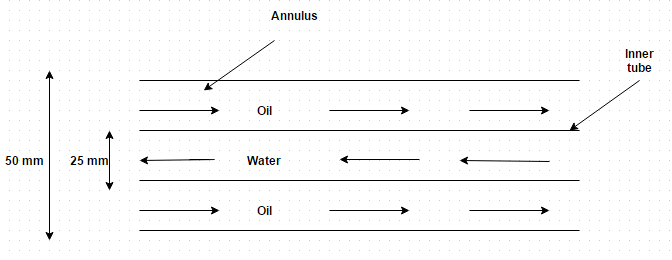MCQs
Total Questions : 47
| Page 1 of 5 pages
Question 1. A single pass shell and tube heat exchanger, consisting of a bundle of 100 tubes (inner diameter 25 mm and thickness 2 mm) is used for heating 28 kg/s of water from 25 degree Celsius to 75 degree Celsius with the help of a steam condensing at atmospheric pressure on the shell side with condensing heat transfer coefficient 5000 W/m² degree. Make calculation for overall heat transfer coefficient based on the inner area. Take fouling factor on the water side to be 0.002 m² degree/W per tube and neglect effect of fouling factor on the shell side and thermal resistance of the tube wall

Answer: Option C. -> 847.46 W/m² degree
Answer: (c).847.46 W/m² degree
Answer: (c).847.46 W/m² degree
Question 2. The lubricating oil for a large industrial gas turbine engine is cooled in a counter flow, concentric tube heat exchanger. The cooling water flows through the inner tube ( diameter = 25 mm) with inlet temperature 25 degree celsius and mass flow rate 0.2 kg/s. The oil flows through the annulus (diameter = 50 mm) with mass flow rate 0.125 kg/s and its temperature at entry and exit are 90 degree Celsius and 60 degree Celsius. Find outlet temperature of cooling water.

Answer: Option C. -> 34.58 degree celsius
Answer: (c).34.58 degree celsius
Answer: (c).34.58 degree celsius
Question 3. A small thermo-couple is positioned in a thermal boundary layer near a flat plate past which water flows at 30 degree Celsius and 0.15 m/s. The plate is heated to a surface temperature of 50 degree Celsius and at the location of the probe, the thickness of thermal boundary layer is 15 mm. If the temperature profile as measured by the probe is well-represented by
t – t S/t INFINITY – t S = 1.5 (y/δ t) – 0.5 (y/δ t)³
Determine the heat flux from plate to water
t – t S/t INFINITY – t S = 1.5 (y/δ t) – 0.5 (y/δ t)³
Determine the heat flux from plate to water
Answer: Option B. -> 1266 W/m²
Answer: (b).1266 W/m²
Answer: (b).1266 W/m²
Answer: Option A. -> 5.83 W/m² K
Answer: (a).5.83 W/m² K
Answer: (a).5.83 W/m² K
Question 5. Atmospheric air at 30 degree Celsius temperature and free stream velocity of 2.5 m/s flows along the length of a flat plate maintained at a uniform surface temperature of 90 degree Celsius. Let length = 100 cm, width = 50 cm and thickness = 2.5 cm. Thermal conductivity of the plate material is 25 W/m K, find heat lost by the plate
Answer: Option D. -> 185.88 W
Answer: (d).185.88 W
Answer: (d).185.88 W
Question 6. Ambient air at 20 degree Celsius flows past a flat plate with a sharp leading edge at 3 m/s. The plate is heated uniformly throughout its entire length and is maintained at a surface temperature of 40 degree Celsius. Calculate the thickness of the hydrodynamic boundary layer. Assume that transition occurs at a critical Reynolds number of 500000
Answer: Option B. -> 17.5 mm
Answer: (b).17.5 mm
Answer: (b).17.5 mm
Question 7. Ambient air at 20 degree Celsius flows past a flat plate with a sharp leading edge at 3 m/s. The plate is heated uniformly throughout its entire length and is maintained at a surface temperature of 40 degree Celsius. Calculate the distance from the leading edge at which the flow in the boundary layer changes from laminar to turbulent conditions. Assume that transition occurs at a critical Reynolds number of 500000
Answer: Option C. -> 2.67 m
Answer: (c).2.67 m
Answer: (c).2.67 m
Question 8. A flat plate 1 m by 1 m is placed in a wind tunnel. The velocity and temperature of free stream air are 80 m/s and 10 degree Celsius. The flow over the whole length of the plate is made turbulent by turbulizing grid placed upstream of the plate. Find the thickness of hydrodynamic boundary layer at trailing edge of the plate
Answer: Option D. -> 16.55 mm
Answer: (d).16.55 mm
Answer: (d).16.55 mm
Answer: Option C. -> 1.347
Answer: (c).1.347
Answer: (c).1.347
Question 10. During test-run, air flows at 215 m/s velocity and 25 degree Celsius temperature past a smooth thin model airfoil which can be idealized as a flat plate. If the chord length of the airfoil is 15 cm, find drag per unit width. The relevant physical properties of air are
p = 1.82 kg/m³
v = 15.53 * 10¯⁶ m²/s
p = 1.82 kg/m³
v = 15.53 * 10¯⁶ m²/s
Answer: Option A. -> 25.42 N per unit width
Answer: (a).25.42 N per unit width
Answer: (a).25.42 N per unit width
















